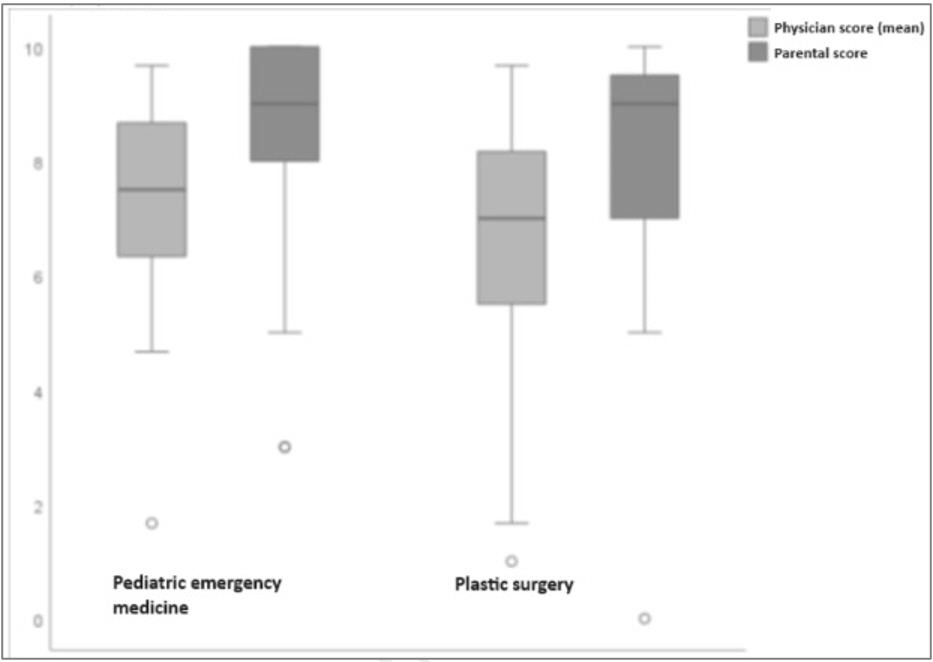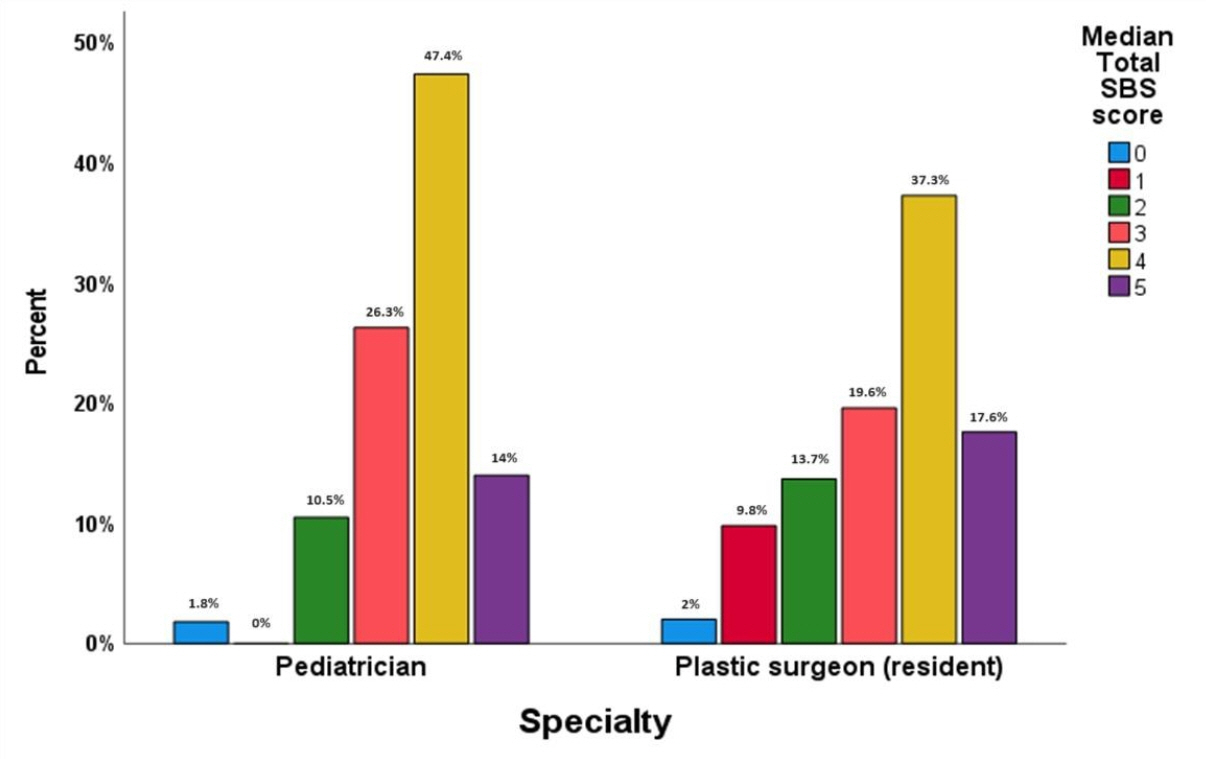Pediatr Emerg Med J.
2024 Apr;11(2):65-70. 10.22470/pemj.2023.00857.
Cosmetic outcomes of simple facial laceration suturing in the pediatric emergency department
- Affiliations
-
- 1The Faculty of Medicine, Hebrew University in Jerusalem, Jerusalem, Israel
- 2Plastic and Reconstructive Surgery Department, Shaare Zedek Medical Center, Jerusalem, Israel
- 3Pediatric Emergency Department, Shaare Zedek Medical Center, Jerusalem, Israel
- KMID: 2554077
- DOI: http://doi.org/10.22470/pemj.2023.00857
Abstract
- Purpose
The long-term cosmetic outcomes of simple facial lacerations have not been well addressed, specifically regarding those of suturing by pediatric emergency physicians (PEPs) and plastic surgery (PS) residents.
Methods
A retrospective study was performed at the pediatric emergency department of Shaare Zedek Medical Center in Jerusalem, Israel. Cosmetic outcomes of simple facial lacerations sutured within 1 year of the study were reviewed using digital photographs taken by legal guardians of children sutured in the department. The photographs were reviewed and rated blindly using the Stony Brook scar score as measures of cosmetic outcomes by 2 plastic surgeons and 1 PEP, as well as the general numeric score (GNS) rated by the guardians and the 3 doctors. The scores were compared between children sutured by PEPs (PEP group) and those sutured by PS residents (PS group). A sample size of 50 children in each study group was calculated to have enough power to show a difference.
Results
Among a total of 108 children who participated in the study (median age, 4.0 years [interquartile range, 3.0-7.0]), 57 and 51 were sutured by PEPs and PS residents, respectively. Guardian-rated median GNS showed no difference between the 2 groups (PEP, 90.0 [70.0-95.0] vs. PS, 90.0 [60.0-90.0]; P = 0.310). In contrast, doctor-rated median GNS was higher in the PEP group (PEP, 75.0 [63.3-86.7] vs. PS, 70.0 [53.3-83.3]); P = 0.046). A Stony Brook scar score of 3 or higher was similarly frequent in both groups (PEP, 87.7% vs. PS, 74.5%; P = 0.173) with a low interrater agreement (Kappa = 0.36).
Conclusion
Cosmetic outcomes of simple facial lacerations in the pediatric emergency department were favorable regardless of the specialty or expertise of doctors. The guardians were more satisfied with the outcomes, compared to the doctors.
Keyword
Figure
Reference
-
References
1. Allonby-Neve CL, Okereke CD. Current management of facial wounds in UK accident and emergency departments. Ann R Coll Surg Engl. 2006; 88:144–50.
Article2. Lee SJ, Cho YD, Park SJ, Kim JY, Yoon YH, Choi SH. Satisfaction with facial laceration repair by provider specialty in the emergency department. Clin Exp Emerg Med. 2015; 2(3):179–83.
Article3. Tebble NJ, Adams R, Thomas DW, Price P. Anxiety and self-consciousness in patients with facial lacerations one week and six months later. Br J Oral Maxillofac Surg. 2006; 44:520–25.
Article4. Omovie EE, Shepherd JP. Assessment of repair of facial lacerations. Br J Oral Maxillofac Surg. 1997; 35:237–40.
Article5. Key SJ, Thomas DW, Shepherd JP. The management of soft tissue facial wounds. Br J Oral Maxillofac Surg. 1995; 33:76–85.
Article6. Singer AJ, Quinn JV, Thode HC Jr, Hollander JE; TraumaSeal Study Group. Determinants of poor outcome after laceration and surgical incision repair. Plast Reconstr Surg. 2002; 110:429–37.
Article7. Hollander JE, Blasko B, Singer AJ, Valentine S, Thode HC Jr, Henry MC. Poor correlation of short- and long-term cosmetic appearance of repaired lacerations. Acad Emerg Med. 1995; 2:983–7.
Article8. Lowe DA, Monuteaux MC, Ziniel S, Stack AM. Predictors of parent satisfaction in pediatric laceration repair. Acad Emerg Med. 2012; 19:1166–72.
Article9. Fearmonti R, Bond J, Erdmann D, Levinson H. A review of scar scales and scar measuring devices. Eplasty. 2010; 10:e43.10. Ministry of Health of the State of Israel. A survey of emergency departments in Israel: first report [Internet]. Ministry of Health of the State of Israel; c2022 [cited 2023 Dec 27]. Available from: https://www.health.gov.il/PublicationsFiles/Malrad.pdf. Hebrew.11. Singer AJ, Arora B, Dagum A, Valentine S, Hollander JE. Development and validation of a novel scar evaluation scale. Plast Reconstr Surg. 2007; 120:1892–7.
Article
- Full Text Links
- Actions
-
Cited
- CITED
-
- Close
- Share
- Similar articles
-
- Clinical Analysis of Pediatric Facial Laceration
- Use of 2-Octylcyanoacrylate(Dermabond(R)) for Repair of Pediatric Facial Lacerations
- The Usefulness of Leukosan SkinLink for Simple Facial Laceration Repair in the Emergency Department
- The Suture Method Using Ribbon Shaped Knot in Pediatric Facial Lacerations
- Clinical Evaluation of Facial Laceration Patients Who Visited Tertiary Emergency Medical Center



